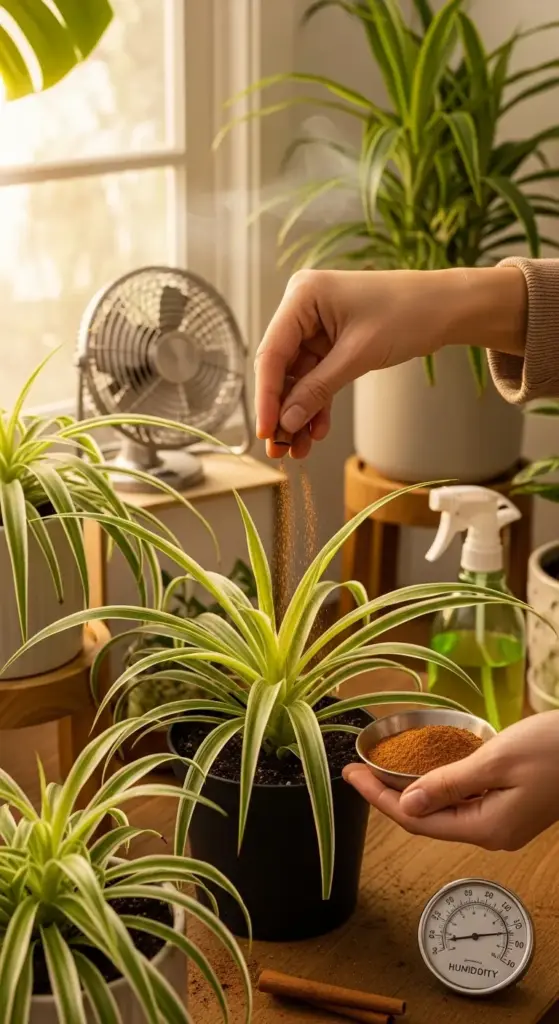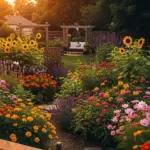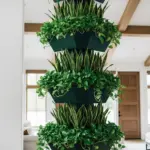Secret #7 – Pest Prevention Through Environmental Control

Nothing breaks a plant parent’s heart like discovering your gorgeous spider plant covered in tiny spider mites or sticky aphids. I’ve been there, and it’s devastating!
I used to think pest problems just “happened” randomly, but after years of trial and error, I realized that 90% of bug issues are actually environmental problems in disguise.
The Cinnamon Trick That Sounds Crazy But Works
This one came from my grandmother’s old gardening journal, and I honestly thought she was losing it. Sprinkle ground cinnamon on the soil surface around your spider plants once a month.
Spider mites absolutely hate the smell of cinnamon, and it also prevents fungal issues that attract other pests. I’ve been doing this for two years now, and my pest problems dropped to almost zero.
The best part? It makes your plant corner smell like a cozy bakery instead of a chemical factory. My guests always ask what smells so good!
Air Circulation: The Game-Changer Nobody Talks About
Here’s what I wish someone had told me years ago – stagnant air is basically a pest invitation. Those tiny bugs love still, humid environments where they can multiply undisturbed.
I added a small oscillating fan to my plant area, and the difference was immediate. Not a harsh wind, just gentle air movement that keeps the environment less appealing to pests.
Proper air circulation also prevents the fungal problems that weaken plants and make them pest magnets. It’s like creating an invisible force field around your plants.
The Early Warning Signs I Wish I’d Known
Before you see actual bugs, your spider plant will start sending distress signals. I ignored these for way too long!
The first sign is usually leaf stippling – tiny yellow or white dots on the leaves that look like someone took a pin and poked holes everywhere. This screams spider mites.
Sticky honeydew on leaves means aphids, even if you can’t see them yet. Check the undersides of leaves immediately – that’s where they like to hide and party.
If your plant suddenly looks dull or loses its shine, that’s often the first sign of pest stress before any visible damage appears.
My Non-Toxic Arsenal That Actually Works
When I had kids, I had to completely rethink my pest control strategy. No more harsh chemicals near curious little hands!
Neem oil became my best friend – it’s completely safe but deadly effective against most spider plant pests. I mix 1 teaspoon per quart of water and spray every two weeks as prevention.
For immediate aphid problems, I use the soap spray method: 1 tablespoon of gentle dish soap in a quart of water. It suffocates the bugs without harming the plant.
The Shower Treatment for Severe Infestations
When my favorite spider plant got absolutely covered in spider mites, I discovered the power of a good shower. Sounds simple, but it’s incredibly effective!
I take the entire plant to the bathroom and give it a thorough rinse with lukewarm water, paying special attention to the undersides of leaves where spider mites love to hide.
The water pressure literally washes the bugs away, and the humidity boost helps the plant recover from pest stress. I do this weekly until the problem is completely gone.
Companion Planting for Natural Pest Control
This trick came from my neighbor who never seems to have bug problems. She keeps basil plants near her spider plants, and the strong scent naturally repels most common pests.
I tried it and was amazed! The basil doesn’t just look pretty – it actually creates a pest-resistant microenvironment around my spider plants.
Mint works too, but be careful – it can take over if you’re not watching. I keep mine in a separate pot to prevent garden domination.
The Humidity Balance That Prevents Problems
Here’s the tricky part – spider plants need humidity, but too much creates perfect conditions for fungus gnats and other moisture-loving pests.
I learned to aim for that sweet spot of 40-50% humidity. Any higher and you’re basically running a bug resort.
Using a hygrometer helped me dial in the perfect balance. When humidity creeps above 60%, I reduce my humidifying efforts until it stabilizes.
My Biggest Pest Prevention Mistake
I used to think that healthy plants couldn’t get pests. So wrong! Even thriving plants can become pest magnets if the environment is right for bugs.
The mistake was focusing only on plant health and ignoring environmental factors like air circulation and cleanliness around the plant area.
Now I vacuum around my plants weekly and wipe down nearby surfaces. Dust and debris create hiding spots for pests to establish themselves.
The Quarantine Protocol That Saves Collections
Any new plant that comes into my home gets a 2-week quarantine period in my bathroom. I learned this after one infested plant nearly destroyed my entire collection!
During quarantine, I inspect new plants daily and treat them with preventive neem oil spray. Better safe than sorry when you’ve invested years in building a healthy plant family.
I also quarantine any plant that shows the slightest sign of pest issues until I’m 100% sure the problem is resolved.
Creating a Pest-Resistant Environment
My current setup includes strategic plant spacing for good airflow, regular cleaning schedules, and those natural deterrent scents scattered throughout the area.
It’s like creating an ecosystem where pests just don’t want to hang out. The combination of air movement, natural repellents, and proper humidity makes my plant corner basically pest-proof.
The key is consistency – these prevention methods only work if you stick with them long-term, not just when problems appear.
Your Spider Plant Success Journey Starts Now
You now have all seven secrets that master gardeners use to grow absolutely stunning spider plants that produce endless babies and turn heads wherever they’re displayed.
The transformation doesn’t happen overnight, but if you implement even just 2-3 of these techniques, you’ll see dramatic improvements within a month. Start with the stress training watering method and strategic light positioning – those two alone will revolutionize your spider plant game!
Which secret are you most excited to try first? Your spider plants are about to become the envy of every plant parent you know!
Conclusion
These seven secrets have transformed my spider plants from basic houseplants into stunning focal points that guests always compliment. The best part? You probably already have most of what you need at home!
Start with just one or two techniques – I recommend beginning with the watering method and light positioning, as these show results fastest. Remember, becoming a master gardener isn’t about perfection; it’s about understanding your plants’ needs and responding with intention.
Which secret are you most excited to try first? Share your spider plant journey in the comments below, and don’t forget to tag a friend who needs these game-changing tips!









GIPHY App Key not set. Please check settings